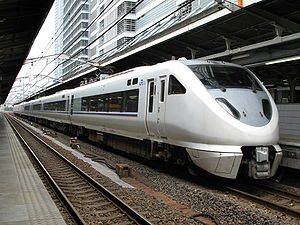683 series
| 683 series | |
|---|---|
 683-2000 series on Shirasagi service, July 2007 | |
| In service | 2001–Present |
| Manufacturer | Hitachi, Kawasaki Heavy Industries, Kinki Sharyo, Nippon Sharyo |
| Family name | A-train |
| Replaced | 485 series |
| Constructed | 2001–2011 |
| Refurbished | 2015– |
| Number built | 270 vehicles |
| Number in service | 270 vehicles |
| Formation | 3/5/6/9 cars per trainset |
| Operators | JR-West (2001–) Hokuetsu Express (2005–2015) |
| Depots | Kyoto, Kanazawa |
| Lines served | Tokaido Main Line, Kosei Line, Hokuriku Main Line, IR Ishikawa Railway Line, Nanao Line |
| Specifications | |
| Car body construction | Aluminium alloy, double-skin |
| Maximum speed | 160 km/h (100 mph)* (683-4000/5000/8000 series) 130 km/h (80 mph)* (683-0/1000/2000/3000 series)[1] |
| Traction system | Variable frequency (3-level IGBT) |
| Electric system(s) | 20 kV AC 60 Hz / 1,500 V DC overhead |
| Current collector(s) | WPS27C scissors-type pantograph WPS28D single-arm pantograph (683-4000/5000 series) |
| Braking system(s) | Regenerative brake, electronically controlled pneumatic brakes, snow-resistant brake |
| Safety system(s) | ATS-SW, ATS-P |
| Multiple working | 681 series |
| Track gauge | 1,067 mm (3 ft 6 in) |
The 683 series (683系, Roppyaku-hachijūsan-kei) is a dual-voltage electric multiple unit (EMU) train type operated by West Japan Railway Company (JR-West) and Hokuetsu Express on limited express services in Japan since 2001.
Variants
- 683-0 series (Thunderbird)
- 683-1000 series (Thunderbird)
- 683-2000 series (Thunderbird, former Shirasagi)
- 683-3000 series (Thunderbird, former Shirasagi)
- 683-4000 series (Thunderbird)
- 683-5000 series (Thunderbird)
- 683-8000 series (Shirasagi, former Hokuetsu Express Hakutaka)
-
683-0 series
-
683-4000 series
-
683-8000 series
Operations
JR-West
- Thunderbird
- Shirasagi
- Biwako Express
- Ohayō Express
- Oyasumi Express
- Dinostar (from 14 March 2015)
- Noto Kagaribi (from 14 March 2015)
- Kuroshio (from 13 March 2015)[2]
Hokuetsu Express
- Hakutaka (until 12 March 2015)
JR Central
- Home Liner Ōgaki rapid service (until 13 March 2015)
- Home Liner Sekigahara rapid service (until 13 March 2015)
Formations
The various formations are configured as follows.
3-car sets
Thunderbird sets
| Designation | Tpc | M | T'c |
|---|---|---|---|
| Numbering | KuHa 682-500 | MoHa 683-1300 | KuHa 683-700 |
| Designation | Tpc | T | Mc |
|---|---|---|---|
| Numbering | KuHa 682-2700 | SaHa 683-2400 | KuMoHa 683-3500 |
| Designation | T'c | M | Tpc |
|---|---|---|---|
| Numbering | KuHa 683-8700 | MoHa 683-8000 | KuHa 682-8500 |
Shirasagi sets
| Designation | Mc | T | Tpc |
|---|---|---|---|
| Numbering | KuMoHa 683-3500 | SaHa 683-2400 | KuHa 682-2700 |
The KuHa 682 cars are each fitted with one scissors-type pantograph.
5-car sets
Shirasagi sets
| Designation | Mc | T | Tp | M | Tpsc |
|---|---|---|---|---|---|
| Numbering | KuMoHa 683-3500 | SaHa 683-2500 | SaHa 682-2200 | MoHa 683-3400 | KuRo 682-2000 |
The SaHa 682 and KuRo 682 cars are each fitted with one scissors-type pantograph.
6-car sets
Thunderbird sets
| Designation | Tsc | Tp | M | T | Tp | Mc |
|---|---|---|---|---|---|---|
| Numbering | KuRo 683 | SaHa 682 | MoHa 683-1000 | SaHa 683-300 | SaHa 682 | KuMoHa 683-1500 |
| Designation | Mc | Tp | T | M | Tp | Tsc |
|---|---|---|---|---|---|---|
| Numbering | KuMoHa 683-8700 | SaHa 682-8000 | SaHa 683-8000 | MoHa 683-8300 | SaHa 682-8000 | KuRo 683-8000 |
The SaHa 682 cars are each fitted with one scissors-type pantograph.
9-car sets
Thunderbird sets
| Designation | Tsc | Tp | M | Tp | M | T | T | Tp | Mc |
|---|---|---|---|---|---|---|---|---|---|
| Numbering | KuRo 683-4500 | SaHa 682-4300 | MoHa 683-5400 | SaHa 682-4400 | MoHa 683-5000 | SaHa 683-4700 | SaHa 683-4800 | SaHa 682-4300 | KuMoHa 683-5500 |
The SaHa 682 cars are each fitted with one single-arm pantograph.
Interior
-
683-2000 series odd number car Standard-class saloon, January 2012
-
683-2000 series even number car Standard-class saloon, January 2012
-
683-2000 series Green car saloon, January 2012
-
683-4000 series Green car saloon, June 2010
Refurbishment

All of the 683 series trainsets used on Thunderbird limited express services are scheduled to undergo a programme of refurbishment from autumn 2015 until the end of fiscal 2018.[3] The first set treated, nine-car 683-4000 series set T51, was returned to revenue service in September 2015.[4]
Conversion to 289 series
From 2015, 85 former Shirasagi 683 series vehicles were converted and reformed to become DC-only 289 series EMUs, formed as three-car, four-car, and six-car sets for use on Hashidate, Kinosaki, Kounotori, and Kurioshio limited express services in the Kyoto and Osaka area.[5]
References
- オールガイド 681・683系. Japan Railfan Magazine. 49 (577). Japan: Koyusha Co., Ltd.: 56–65 May 2009.
{{cite journal}}: Unknown parameter|trans_title=ignored (|trans-title=suggested) (help) - 北越急行681・683系. Japan Railfan Magazine. 49 (577). Japan: Koyusha Co., Ltd.: 46–55 May 2009.
{{cite journal}}: Unknown parameter|trans_title=ignored (|trans-title=suggested) (help) - JR電車編成表 '07冬号. Japan: JRR. December 2006. ISBN 4-88283-046-9.
{{cite book}}: Unknown parameter|trans_title=ignored (|trans-title=suggested) (help)
- ^ JR全車輌ハンドブック2006 (in Japanese). Japan: Neko Publishing. 2006. ISBN 4-7770-0453-8.
{{cite book}}: Unknown parameter|trans_title=ignored (|trans-title=suggested) (help) - ^ "Railnews". Japan Railfan Magazine (in Japanese). 55 (647). Japan: Koyusha Co., Ltd.: 171 March 2015.
- ^ より快適に!北陸~近畿を結ぶ特急「サンダーバード」、車両リニューアルへ (in Japanese). Japan: Tetsudo Shimbun. 28 January 2015. Retrieved 28 January 2015.
{{cite web}}: Unknown parameter|trans_title=ignored (|trans-title=suggested) (help) - ^ 683系4000番台リニューアル車が営業運転を開始. Japan Railfan Magazine Online (in Japanese). Japan: Koyusha Co., Ltd. 27 September 2015. Retrieved 28 September 2015.
{{cite web}}: Unknown parameter|trans_title=ignored (|trans-title=suggested) (help) - ^ JR電車編成表 2016冬 (in Japanese). Japan: Kotsu Shimbunsha. 18 November 2015. p. 145, 190. ISBN 978-4-330-62315-3.
{{cite book}}: Unknown parameter|trans_title=ignored (|trans-title=suggested) (help)







